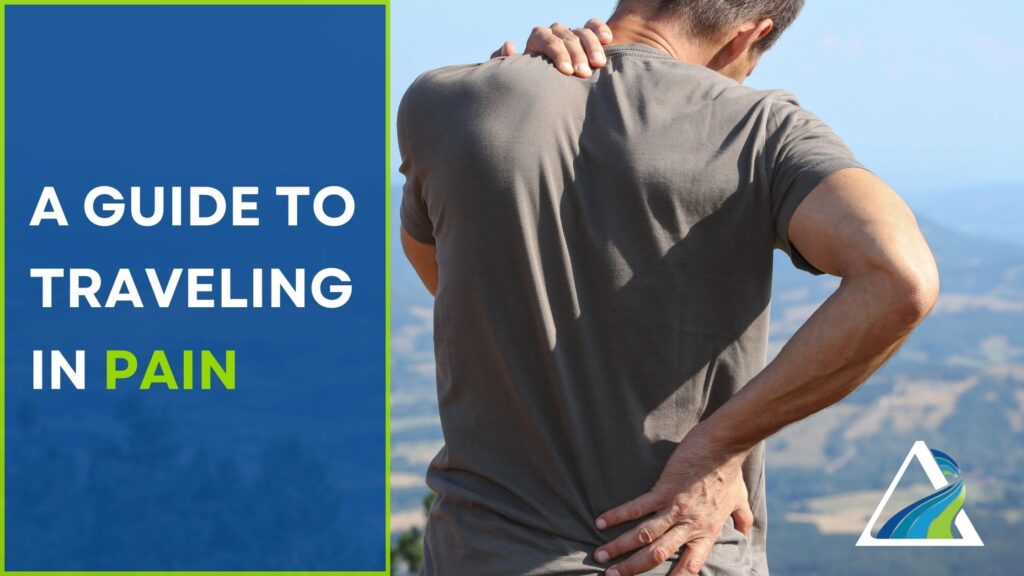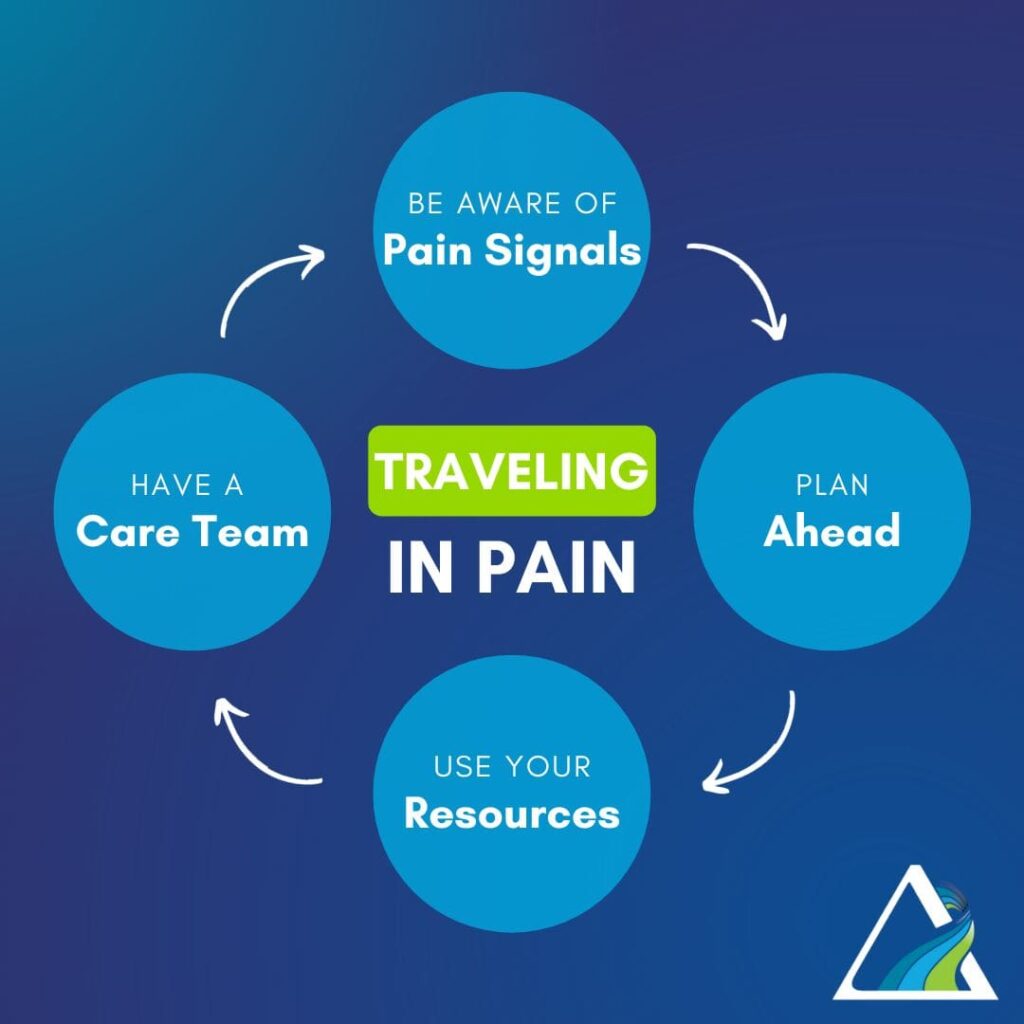
Embarking on a journey while dealing with pain can present unique challenges. Whether you live with chronic or acute pain, recognizing your body’s signals, planning, utilizing resources, and having a care team are essential elements for a smoother travel experience.
Before the Trip
Communicate with your Care Team
Communicate with your care team about traveling with chronic or acute pain conditions. Explain the duration of the trip and the modes of travel. Together, you can create a plan of care to reduce pain and improve your comfort based on your travel and daily activities.
If a physical therapist is currently treating your pain, then you are being seen by an expert in movement with a deep understanding of the conditions of your body.

” During 2021, an estimated 20.9% of U.S. adults (51.6 million persons) experienced chronic pain, and 6.9% (17.1 million persons) experienced high-impact chronic pain (i.e., chronic pain that results in substantial restriction to daily activities) with a higher prevalence among non-Hispanic American Indian or Alaska Native adults, adults identifying as bisexual, and adults who were divorced or separated.”
Rikard SM, Strahan AE, Schmit KM, Guy GP Jr.. Chronic Pain Among Adults — United States, 2019–2021. MMWR Morb Mortal Wkly Rep 2023;72:379–385. DOI: http://dx.doi.org/10.15585/mmwr.mm7215a1.
Give Yourself Extra Time and Focus to Pack
Adequate packing time helps reduce stress before, during, and after the trip. Advance planning reduces stress and anxiety improving your ability to manage your pain.
Things to consider packing when traveling with pain:
Carry-On Luggage
Expect the unexpected and have your most important items in your carry-on. Prepare for lost baggage, delays, and other travel challenges. Avoid unnecessary pain by having your necessities with you.
- Place “pain management must-haves” in your carry-on or have them handy.
- Include a printout of your exercise program for the duration of your trip.
- Fill prescriptions or pain medicine in advance and include three days’ extra supply.
- Pack medications and pain relievers in your carry-on.
- Pack a record of your condition and a list of the medications you’re taking.
- Pack stick-on, disposable heating/cooling pads and a neck pillow in a handy location.
- Pack an empty, reusable water bottle.
Suitcase
Have the items you need to be comfortable when awake and at rest. Changing your environment and routine will challenge your body. Be prepared with these tips.
- Wear and pack a good pair of shoes for walking, standing, or even running—two-pair minimum.
- Pack everything that helps you get your best night sleep.
- Pack foods/snacks that are consistent with your health needs and won’t cause inflammation.
Purchase Tickets In Advance
The earlier you can book your travel, the better the opportunity to select a seat and to buy as much comfort as you can afford.
Select business or first class when possible. Choose a seat that will allow extra space and monitor for seat changes.
Aisle seats enable easier movement during your flight. Take time to stretch and perform breathing exercises. Don’t be shy about asking your neighbors to let you get up to stretch throughout the journey.
Ship Bulky Items to Your Destination
Traveling with items including luggage, golf clubs, and skis will increase your risk of pain.
Companies like Luggage Free, Send My Bag, and Lugless deliver directly to your accommodations.
Remember to not ship any necessities for comfort—keep your pain management must-haves in your carry-on.
National Institutions of Health. News Releases: NIH study finds high rates of persistent chronic pain among U.S. adults, 16 May, 2023, https://www.nih.gov/news-events/news-releases/nih-study-finds-high-rates-persistent-chronic-pain-among-us-adults
- The incidence of new chronic pain cases was high, at 52.4 cases per 1,000 persons per year. This is compared to other common chronic conditions, such as diabetes (7.1 cases/1,000 per year), depression (15.9 cases/ 1,000 per year), and hypertension (45.3 cases/1,000 per year).
- Among those who had reported non-chronic pain in 2019, about 1 in 6 (14.9%) said they had chronic pain in 2020, pointing to the importance of early management of pain.
- Chronic pain is highly persistent, with almost two-thirds (61.4%) of those who reported chronic pain in 2019 still reporting chronic pain a year later. Chronic pain developed into HICP at a rate of 190 cases/1,000 per year, and 361 cases/1,000 per year of people who had initially reported HICP were still suffering a year later.
- About 1 in 10 (10.4%) of people with chronic pain in 2019 recovered and were pain free in 2020.

Air Travel—Taking a Flight in Pain
Travel can be painful even when you are not in pain.
Skip Security Lines
A common concern we hear at CORA Physical Therapy is patients who are worried about standing still, then walking.
TSA Pre Check can expedite the security screening portion of air travel considerably. Use the Department of Homeland Security’s interactive Trusted Traveler Tool to find the program that fits your needs.
You may qualify for medical assistance and request a wheelchair or guide. Airports are required to provide assistance. Check with your airline provider first, then the airport to request this assistance. Call 48-hours in advance of your departure and arrival at both ends of your trip.
To learn more about the services available, reference this article from the U.S. Department of Transportation on Wheelchair and Guided Assistance.
Waiting for Your Flight
Once you are through security, get to your gate early.
Move around to keep up good circulation because it won’t be as easy on the plane
Take a moment to inform the gate attendant that you would like medical assistance on the plane. More on that below.
Travel like a VIP
Take advantage of early boarding.
Even if you are not using a wheelchair, you can still use this accommodation. Most chronic and acute pain is invisible to the outside world, and airline agents are trained to assist anyone that “self-identifies” as needing this service.
Research whether your airline or credit cards can get you into airport lounges. These lounges are spacious and are designed to provide convenience and comfort while traveling.
To ease stress for travelers, airports are seeing a rise in airport spas and massage stations. If you don’t want to spend money on a spa, some airports have yoga and meditation rooms to help.
Assistance to the Plane and Beyond
The Air Carrier Access Act (ACAA) provides airlines, both foreign and domestic, a rule of law with definitive rights for passengers of all flights traveling within, to, or from the United States.
To learn more about ACAA and your rights as a citizen, then follow this link: here.
World Health Organization. Low Back Pain, 19 June 2023, https://www.who.int/news-room/fact-sheets/detail/low-back-pain
- In 2020, low back pain (LBP) affected 619 million people globally and it is estimated that the number of cases will increase to 843 million cases by 2050, driven largely by population expansion and ageing (1).
- LBP is the single leading cause of disability worldwide and the condition for which the greatest number of people may benefit from rehabilitation.
- LBP can be experienced at any age, and most people experience LBP at least once in their life.
- Prevalence increases with age up to 80 years, while the highest number of LBP cases occurs at the age of 50–55 years. LBP is more prevalent in women (2).
- Non-specific LBP is the most common presentation of LBP (about 90% of cases).
Ground Travel –Traveling in Cars and Trains in Pain
Consider Every Stop a Rest Stop

Long periods of time between stops can make pain worse.
This is especially true for older adults, and those with chronic pain including back and neck. Use rest stops to your advantage.
Rest stops are a good time to treat yourself with a stick-on heating pad.
A short walk will improve circuluation and relaxation.
If you are in physical therapy, perform exercises from your home-care program. Focus on breathing, alignment, posture, and relaxing.
Renting a Car
Rent a car that gives you enough space, and opt for a vehicle with automatic opening doors and trunks.
If you’re considering a handicap-accessible van, know that not all rental companies offer them. Do your research and make phone calls to the locations you are doing business with.
Taxis and App-based Rides
Options are on the rise for comfortable rides with either taxis or car-sharing services.
Uber offers UberWAV, and Lyft has a variety of transportation types.
If you are not an app person or not in a region that offers this service, then your traditional taxi services MUST be told that you require a vehicle that is accessible for your condition.
Traveling on Trains in Pain
Trains are by far the most comfortable solution for people with chronic pain.
You have more space to sit, and you can stand up, stretch and even walk around anytime you’d like.
If you are prone to motion sickness, a front-facing seat is your better bet. Always keep your carry-on bag close to manage stress and pain.
Sea Travel in Pain
Check to see if all ports of call are ADA-compliant. Even if you don’t absolutely need an ADA-compliant port, it is best to plan ahead.
If chartering a boat, ask the company if it would like a copy of your prescriptions and a note of your condition from your doctor and physical therapist.
If you have a wheelchair and are traveling on a cruise, book a room that is close to the elevator so you’re conveniently located for rest or fun. Also, ask for a room that is wheelchair-accessible and ADA-compliant.
Bonus Tips
- Triple-check your essentials and your carry-on must-haves.
- Have your medical information with you at all times. Whether on a piece of paper or a medical alert bracelet or app, keep a list of your medications along with your doctor’s name and number.
- Pack as lightly as possible.
- Check for discounts for those who require special services or are limited to experiencing all the travel company has to offer.
- Consider travel insurance protection if you’re concerned that the trip you booked and the condition you have may not sync up when travel time comes.
Travel in Comfort
Speak with a Physical Therapist
The Journey Ahead
The goal of this article is to empower you to travel as much as your heart desires.
Any time is the right time for the treatment of pain. We encourage everyone to pursue care.
Travel is one of the best things you can do to stay active, stay healthy, and increase the quality of your life instantly.
For more information about traveling and how physical therapy can benefit you, contact a local physical therapist to go over options and solutions.
